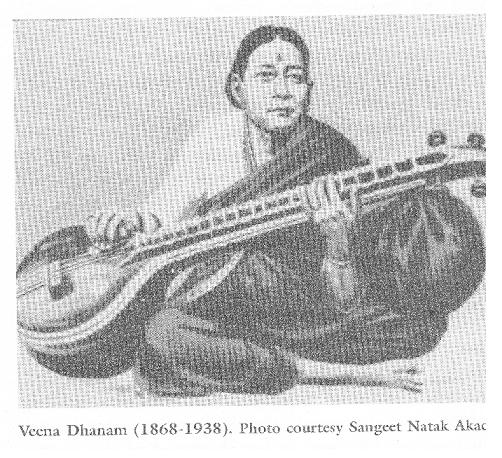Contribute
| Veena Dhanammal: All For The Chamber And None For The Hall |
Haribabu Arthanari
03/17/2011
Dhanammal, the epitome of classical carnatic music, single handedly catalyzed a paradigm shift in her genre and brought about an inimitable style (The Dhanammal Bani), which is the holy grail for most aspiring musicians. She broke the barrier in the then male-dominated arena, gaining respect and admiration from all her peers and contemporaries. She was a force to reckon with in Carnatic music.
Who was Veena Dhanammal?
Dhanammal hails from the devadasi tradition ("servant of God") where women dancers where dedicated to the temple. Indeed, a list of four hundred women dedicated to the shrine can be found in the inscriptions in the Brihadeesvarar temple at Thanjavur. We could trace Dhanammal's lineage to Papammal, who was a dancer in the Tanjore court. Papammal's granddaughter, Kamakshi, was not only a dancer in the court of King Sarabhoji but also a direct disciple of Subbaraya Sastry (son of Syama Sastry). Dhanammal,(born 1868) the granddaughter of Kamakshi thus inherited an enviable repertoire of Subbaraya Sastry and Syama Sastry compositions. Dhanammal had an unquenchable desire to learn new compositions and did so from a number of musicians, including the rarest of Kshetragna's padams from Walajapet Baldas Naidu. Having acquired these rare pieces she would stamp them with her own distinctive style. Dhanammal was a maverick choosing the Veena in an era where the instrument was entirely male dominated. Yet she carved her own niche in developing her own style to reproduce the minutest nuances of human voice. This involved a special fingering technique, which would bring out long stretches of unbroken melody with minimum interference from plucking. To Dhanammal the Veena was a complete instrument and needed no accompaniments.
Dhanammal's artistry and the quality of her music drew a number of composers and musicians to her house. Amongst the composers who frequented Dhanammal's home were Thiruvotriyur Thyagaiyer and Dharmapuri Subbarayar . In fact Dharmapuri Subbarayar even composed a few compositions centered on Dhanammal (Samarasundara, Paras; Saki prana, Chenchurutti). Dhanammal also influenced a number musicians of her generation, these include Ariyakudi Ramanuja Iyengar, S.Rajam, Musiri Subramania Iyer, Papa Venkataramaiah and T.N Rajaratnam Pillai. T.N Rajaratnam Pillai said "She was my last guru, I learnt whatever I could about refinement in music from Dhanammal". In addition to Carnatic musicians, a number of Hindustani musicians admired Dhanammal's musical acumen and the admiration was mutual. Abdul Karim Khan and Dhanammal were good friends and Dhanammal even taught him Entha Veduko, a Thyagaraja composition.
Who was Veena Dhanammal? She was a teacher, a student, a critic, an admirer of music, a performer of incomparable skill and an ultimate embodiment of classicism. However, the essence of Dhanammal and her music was perhaps most eloquently expressed by the first Sangeetha Kalanidhi, T.V. Subba Rao. The following is an excerpt of a description of Dhanammal and her music by T.V. Subba Rao.
"To analyze her art would be to arrive at the essentials of good music… She was extremely sensitive to the minutest differences of pitch and the scrupulous care with which she tuned her veena was an example to all musicians…There have been vainikas who have exhibited great power and range but few have equaled her in softness and delicateness of touch. The most commendable quality in her was the strict economy in the choice and use of phrases and embellishments …She always presented the core, the very soul of melody, the quintessence of music, like the distilled perfume of a wilderness of flowers. Another characteristic of her art is her fidelity to sampradaya or the classical tradition. Her forte, however, was the skill with which she rendered the sumptuous padams of Kshetragna. In this she had no equal. Her taste for classicism never declined, and her exposition never failed to be regarded as the standard of unquestionable authority. Her presentation of the shahitya was the clearest possible for a musician and one was apt to wonder whether she was not more appealing with her voice than with the veena… Her music was the ecstatic outpouring of a heart that felt and a mind that knew true beauty in sense and sound. The normal bent of her mind being more emotional than intellectual, her renderings were full of feeling and passion…Her ideas were subtle; her touch was soft; her shading delicate; her graces elegant; and her play, the crown of refinement. The march of her style was slow, stately, and unbroken. We never felt being hustled along with breathless speed, without pause or relaxation. Aesthetically she was an unbending aristocrat, and her art was all for the chamber, and none for the hall. She could appeal only to the initiated; the multitude did not understand her. To the end she bore aloft the standard of Carnatic music with unflagging zeal and vigor."
In honor of this iconic figure in the history of Carnatic music, MITHAS will be presenting a special concert entitled "A Tribute to Veena Dhanammal", a vocal concert by Balasubrahmaniyan (Wesleyan University), a student of the Dhanammal School. He will be accompanied on the violin by Suhas Rao and on the mridangam by Pravin Sitaram. This will be a unique concert featuring rare masterpieces and musical forms. The concert will be held at the Wong Auditorium on March 27th 2011 at 4pm and will be preceded by a fifteen minute audio-visual presentation on Veena Dhannamal.
The following books and recordings were referred to in writing this article.
1) The Madras Quartet: Women in Karnatak Music By Indira Menon
2) A lecture on Veena Dhanammal By V. Sriram (audio recording)
3) Veena Dhanammal: The Making of a Legend By Lakshmi Subramanian
You may also access this article through our web-site http://www.lokvani.com/
